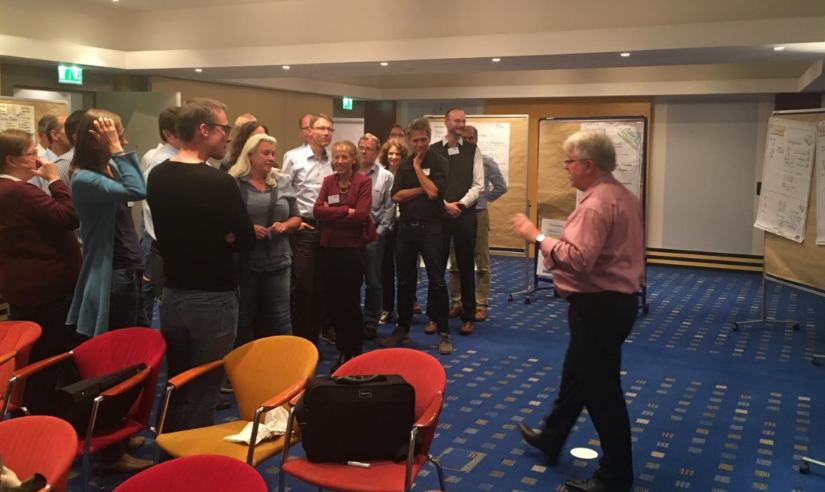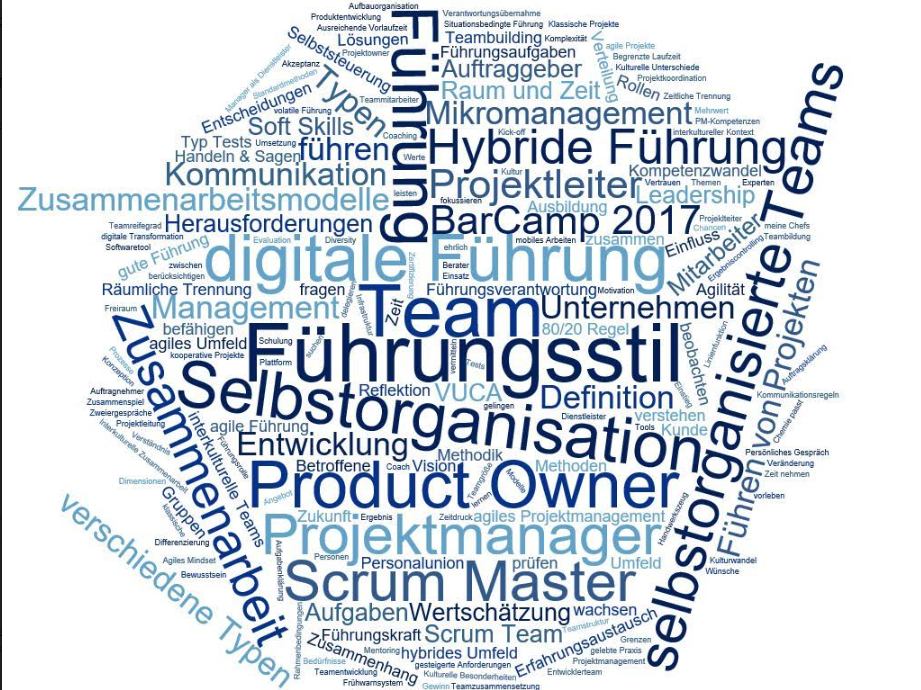Summary
The article examines how working in programs has changed due to the exclusively virtual way of working. Special attention is paid to the changes in governance, working methods and perception of hierarchy in the company. This contribution is accompanied by a survey on some hypotheses on the future of leadership especially under the aspect of distributed work in order to support or reject these hypotheses. Nevertheless, I will try to formulate some future prognoses on this subject already now. The article wants to give some hints which experiences we should in any case take with us into the “new normality” and thus firmly anchor them in our way of working. People and companies who do not learn and adapt from this crisis and only want to return to a supposed old normality will fail in the future.
Flashback
On March 2nd I did not go to North Rhine-Westphalia like every week before, because I had cold symptoms and since a few weeks the corona virus was on everyone’s lips, also in our program. So I thought it would be appropriate not to endanger my colleagues in the project and planned one week of remote work. Thought, done. Being one of the few “local” colleagues not to be on site, as expected, led to a lot of more time being spent for work, as now much had to be done via team video call. And this in planned meetings, which was perhaps previously easily clarified across the desk. In the course of that week, my company decided to stop all non-essential business trips and let me work exclusively from my home office. What can I say, the next few weeks were pure stress, because all the meetings, which were previously held locally and often hybrid, were now virtualized, which led to many additional hours of work. Despite my 5+ years of experience in pure home office (globally virtual distributed programs or project portfolios) in my 20+ years of experience in project and program management, virtual work during Corona was another dimension. I would like to go into this in the course.
This personal (including capacity-) crisis has, as often, also led to something better. What exactly has changed?
Changes in governance et al.
When it comes to governance, many people think first of meetings and the committee structure. This is fundamentally correct, but it is not complete. My calendar was overloaded the first 3-4 weeks of purely virtual work, because now a meeting was often set up virtually for many “little things” and then 30 minutes with colleagues was the lower limit. Thanks to Outlook. I immediately remembered the 22-minute meetings. The goal is to have meetings in
- 22 minute slots,
- to have a clear agenda,
- ideally, distribute written reading material on the topic of the meeting in advance and in good time,
- start the meeting on time and have a clear focus.
I have configured my Outlook so that meetings last either 25 minutes or 50 minutes by default. Here the settings in Outlook help to ensure this. My experience in the virtual environment is that meetings last until the planned end. On site meetings last until someone has to leave because they are changing rooms. Moving from one room to another demand time. In the virtual environment this is usually not granted. Often there is not even time for bio breaks. Unbelievable!
In order to avoid the overcrowded calendar, a daily stand-up meeting of the teams should also be planned in the virtual environment. Here it is important that appropriate video conferencing and collaboration tools are used. I use Planner from Microsoft or Trello in my volunteer work to support backlog, spintplanning and standups. With both boards, the daily stand-up meeting with a core team of a program or, as with me currently, the project portfolio management team of typical up to 7 direct reports can be supported very well. Sprint planning and retroperspectives are of course also included.
Another proven meeting sequence is to schedule escalation and decision meetings ideally several times a week and, in the best case, cancel them if nothing needs to be decided or addressed. These fixed regular dates allow for quick decisions, even in times when the calendars of our senior management are full. Should the need arise to be more than once or twice a week, the role descriptions, RACIs etc. must be checked carefully. Then, in my experience, there is not enough information and decision-making authority at the right level. Basically, my remarks on governance and escalations apply here, of course.
Due to the complete virtualization of all meetings, I have noticed a democratization of these meetings. Anyone can switch on the webcam and be present in a prominent position, unlike in hybrid meetings. Anyone can use the “raise hand” function in the collaboration tool. Everyone can see what is being drawn on the virtual whiteboard and not somewhere on a locally available flipchart. Everybody – and not just the local senior management at the table – can be seen equally in the gallery view of the video software. Quietly and secretly, this changes the style of the meetings and, above all, the greater participation of formerly “never-in-meeting room attendees”, because they are, for example, offshore.
Overall, an asynchronous working of the team is to be enabled, e.g. by check-ins in the morning (these can also be created manually in Microsoft Teams). For teams that work on different topics and only interfaces are relevant or where for whatever reason the daily stand-ups are not possible, the check-in approach is recommended in any case. An active exchange on the check-ins should take place via the comment function. Otherwise there is no added value. If a person asks the check-in question manually, no automatisms have to be established via additional tools. In my team we had solved this manually in MS Teams in which a colleague set the daily question at the start of work.
Due to the higher concentration/stringency of virtual meetings, team members quickly notice exhaustion due to the high sequence of meetings. The one or the other coffee talk can then be made possible virtually.
For me, the more intensive cooperation – intensive because of the even higher level of structuring – has confirmed that the team composition is particularly relevant as already described in 2019. For me, in the intensive virtual cooperation I noticed a weaker expression of the intercultural differences. Perhaps this is related to the democratization described above. Here it would be interesting to know what your experiences are about this. Please put them in the comments. Furthermore I have put up a few hypotheses on which I would like to hear your opinion in this Google Form.
Your more advanced hypotheses are welcome in the comments below.
Does Corona bring long-term changes?
This almost philosophical question was already intensively discussed in the media months ago and many authors came to the conclusion that the corona pandemic will change many things positively in the long term. More regionality, less travel, more … I believe realistically, many positive aspects will be forgotten, despite the long duration of the restrictive measures.
Even when the volcano Eyjafjallajökull erupted in Iceland, many had predicted that air traffic would be reduced in the long term. Immediately after the volcanic ash had blown away, air traffic was back at a very similar level.
Maybe some things will change due to the fact that nobody else could work the same way as before during the Corona ban and some things have hardened due to convenience or because companies have taken measures to avoid further shocks. Everyone, including sales representatives, conducted virtual customer conversations and were forced to work with “the unimaginable”. Let’s see.
Ultimately, the further development of the technology will anchor one or the other change in the long term, because ultimately cost-benefit considerations are always applied by individuals and companies. So we can hope that my forecast of changes as described in the article Project Manager in 2030 will come true. Perhaps our ethical and moral approaches have changed so much during Corona, which will directly lead to a change in our common future.
Which changes should be “cemented”?
The crisis described at the beginning leads to transformation. How the transformation develops and solidifies cannot be guessed in advance. Nevertheless one should of course try to “build in” as many positive aspects as possible.
Due to the asynchronous mode of operation in virtually distributed teams, early intermediate work results should be shared in any case – in line with WOL. In the office on site, the interim status review is often provided by informal coffee break conversations, which allows the maturing “product” to receive continuous feedback. In the virtual world, as much as possible of the semi-finished product should be shared in a structured way.
It is also useful to check whether your own self-organization tools are still the right ones, even when working remotely.
What I have firmly decided to do is that even if everyone else around me falls back into the “post-volcanic eruption-back-to-normal” effect, I will work virtually in a team in my programs at least every third week in order to constantly put the program into remote operation. Otherwise many positive effects will be lost.
We should also avoid hybrid meetings in the future. If parts of the team are remote, then everyone should go to virtual meetings because of the “democratization” described above and the higher effectiveness.
The definition of the communication principles in the project gain more importance due to the necessary home office work, because a formalization with more asynchronous work is absolutely essential.
There is one more thing we should maintain: The care for each other and the often heard, in my opinion, serious statement: “Stay healthy!” In this sense… Stay healthy.
Your hypotheses?










